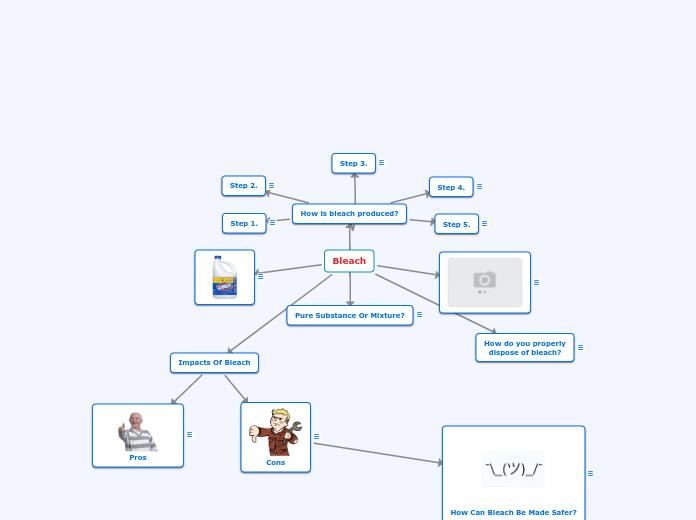por Olivia MacKay 6 anos atrás
460
Bleach ! Cleaning Products
Bleach is produced through a series of steps starting with the collection of seawater, which is then subjected to an electric current to separate it into chlorine and sodium hydroxide.

por Olivia MacKay 6 anos atrás
460

Mais informações
There are quite a few more negatives then positives when it comes to bleach and the environment. A big one is when big company's that produce bleach are in the process of making the bleach, it creates a lot of fumes. These fumes are forced to exit the building, going into the air and affecting ecosystems. Another con is that bleach companys tend to dump large amounts of bleach into bodies of water. This is a problem because its more difficult for the bleach to turn into salt water, meaning that the bleach is still very toxic, killing organisms that enter that now toxic water.
There are two main ways you are able to make bleach safer for you and the environment around you. The first way is by using chlorine free bleach. It is a lot less dangerous and strong. An example is oxygen based bleach. The final thing you can do, is make sure all of your cleaning products are properly disposed of. If you are ever unsure and it's not on the package, you can always check online.
Alternatives To Bleach
Bleach has some properties to it that are good to the environment. One good property is the fact that 95-98% of it turns back to salt water when properly disposed of. Another good quality about bleach is that when bleach is used at very little amounts, it can purify water. When used in larger bodies of water, or pools, it can also purify the water, and also preserve the quality of it.
Bleach is fairly easy to dispose of properly. All you need to do is dilute it with a lot of water, and you can flush it down the sink or toilet. It's a much bigger problem when the bleach is mixed with other cleaners. When bleach is mixed with any cleaner that contains ammonia, it can lead to much larger problems. The mixture of the two can either lead to chlorine vapors, which are toxic vapors that can lead to nausea, Headaches, fainting etc. Although these vapors are bad, they aren't too harmful when outside as it just evaporates away (It's still bad for the environment, but when VERY well ventilated, it won't cause too much long term damage). However, it can also turn liquid hydrazine with different cleaners. Liquid hydrazine is more toxic and in some cases, has been fatal. When flushing these products down the drain its is still somewhat okay because it is highly combustible, but if someone were to just dump out any of these toxic products (Including bleach) outside, there's a possibility that an animal, plant or ecosystem can be effected and it could be fatal.
It is then packaged and released to be bought by consumers.
Clorox bleach only contains 7% of this mixture, so they then add stablizers and cleaning agents.
They then add the sodium hydroxide (From earlier) and more water, so its not as strong.
The chlorine is now in its gaseous for, so now they boil it to turn it into sodium chloride.
Sea water is collected, and an electric current is sent through it. The water evaporates, leaving behind pure chlorine and sodium hydroxide.
Bleach is a mixture because it uses a few different chemicals, stabilizers and cleaning agents to make Clorox bleach.